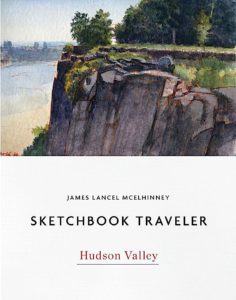As New York moves into the darkest days of the pandemic, we all patiently wait for the crisis to pass. Yesterday, I published the first in a series of daily website blog-posts, of writings and artworks that celebrate personal mobility, in pursuit of mindful engagements with history, nature and the environment. In relation to a finished painting, or an essay, this process is no less a work of art than is the tree to the fruit it bears. In a sense, this practice may be ceremonial, acts of reverence, in beholding the world around us. Offered as messages of hope and solidarity, these posts will appear every day, until this pestilence subsides.

North-South Lake. Hudson Valley Sketchbook. 2016. Collection Hudson River Museum, Yonkers, New York
Extending westward from the Catskill Escarpment, twin lakes rest in a broad vale between North and South Mountains. On its eastern rim, the Catskill Mountain House site is now a wide grassy ledge. Westward, the land rises toward Tannersville. Before European invaders built settlements in the mountains, indigenous farmers lived in the bottomlands, using the heights as their hunting-grounds. Dutch expansion into the region triggered resistance, which escalated into warfare. Crops were destroyed. Settlements scattered, clearing the way for modern economies. Exploring the mountains in the 1740s, Philadelphia naturalist John Bartram discovered new plant species. At age fourteen his son Billy had demonstrated a passion for drawing. In 1755 Bartram writes: “I design to set Billy to draw all our turtles with remarks, as he has time, which is only on Seventh days in the afternoon, and First-day mornings; for he is constantly kept to school to learn Latin and French.”
Father and son had traveled to the Catskills two years prior, visiting North-South Lake. Attracted to a large growth of Auricularia auricula-judae, the boy was about to test it with his foot when his father pulled him back, away from a coiled rattlesnake. Under protest from both father and son, their guide put the creature to death.
Having made notes on site, I added a map in overlay, and beside it a thumbnail of Sanford Gifford’s view from Sunset Rock, which I had visited earlier in the day. Over the years I have come to regard any location on the surface of the earth as a palimpsest, not just as living things clinging to the rocky crust of a molten orb, but as residue of our memories and desires inscribed upon the terrain.
(A preview of SKETCHBOOK TRAVELER by James L. McElhinney (c) 2020. Schiffer Publishing).
Copyright James Lancel McElhinney (c) 2020 Texts and images may be reproduced (with proper citation) by permission of the author. To enquire, send a request to editions@needlewatcher.com
